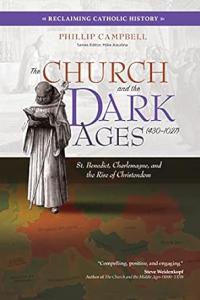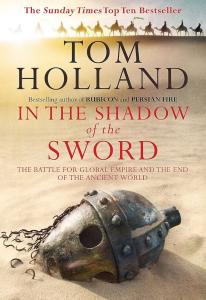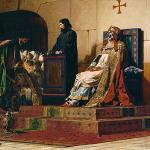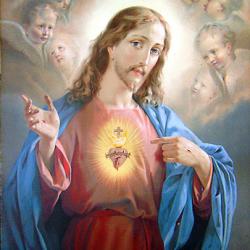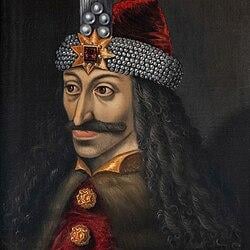Popes 40 – 51: All Saints 1 Great
EXCEPT # 50 Anastasius II.
Earliest pope not canonized by either the Latin Church or the Eastern Church.
2 Anti – Popes
Countless histories of the Catholic Church have been written by exalted historians, to instruct those in the pews on the story of their Church and, more urgently, to exalt the reputations of the historians. These efforts largely have failed, in both regards. The historians are little remembered, and little of what they taught has been absorbed by Catholics who have read their histories or who have watched the motion picture adaptations. The sad result is that most Catholics know only disjointed fragments of Church history, but that is better than not knowing anything at all. In these [posts] the disjointed fragments have been [attempted to be] collected, for the recollection of said Catholics and for the instruction of The Next Generation.
Karl Keating, 1054 and All That: A Lighthearted History of the Catholic Church(2022) Rasselas House.
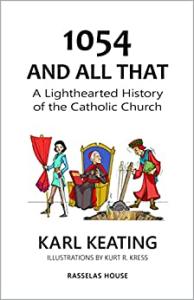
400 CE – Oxyrhynchus Hymn –The Oxyrhynchus hymn, named for the Egyptian archaeological site in which it was discovered, is the oldest Christian hymn with both music and lyrics in recorded history. Uncovered in 1918, the Oxyrhynchus hymn tells historians both about early Christian practices and the spread of language and culture in the Roman empire circa 400 CE. The hymn is written in ancient Greek and asks for the world to be silent as the singers celebrate God. The original papyrus can be visited at the Sackler Library in Oxford. 13 Oldest Hymns In The World – Oldest.org
Christ will not say to me what he said to the Jews: You erred, not knowing the Scriptures and not knowing the power of God. For if, as Paul says, Christ is the power of God and the wisdom of God, and if the man who does not know Scripture does not know the power and wisdom of God, then ignorance of Scripture is ignorance of Christ. Ignorance of Scripture is Ignorance of Christ – Jerome – Crossroads Initiative
Jerome became a Doctor (One of the four Great Latin Fathers) of the Church in 1298
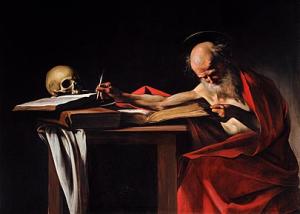
Caravaggio, Saint Jerome Writing
Jerome – Father, Doctor and Warrior – Podcast – Crossroads Initiative
405 – Roman Christian poet Aurelius Prudentius writes the hymn ‘Of the Father’s Love Begotten’.
The Lantern Bearers (1959) is a historical novel for children by Rosemary Sutcliff. Set in Roman Britain during the 5th century, it is the story of a British Roman’s life after the final withdrawal of Roman troops (around 410). Sutcliff won the annual Carnegie Medal from the Library Association, recognising the year’s best children’s book by a British subject.
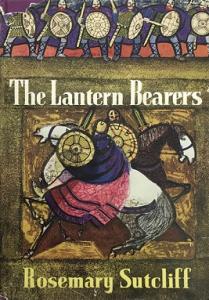
413: St. Augustine, Bishop of Hippo, begins to write The City of God.
426 – Dr. St. Augustine of Hippo publishes the De Civitate Dei, City of God.
432 – St. Patrick does his missionary work in Ireland.
This is the period of European history, roughly from the death of St. Augustine in 430 to the Peace of God in the year 1027, commonly known as the Dark Ages. When people refer to the “Dark Ages,” they are making a value judgment about a historical epoch, whether they know it or not. As we may gather from the use of the word dark, that judgment is negative. Why is this? The centuries of the Dark Ages are sandwiched between the late classical era—characterized by the decline and fall of the Roman Empire—and the High Middle Ages and Renaissance, which succeeded them.
by
Pope # 43 St Celestine I (September 10, 422 –July 27, 432 )(9 years, 321 days) Pope during the Council of Ephesus (431), the third ecumenical council recognized by the Catholic, Eastern Orthodox, and Oriental Orthodox churches.
Catholic Ecumenical Council # 3
The Council of Ephesus (431)
This council repudiated Nestorianism, proclaimed the Virgin Mary as the Theotokos (“Birth-giver to God”, “God-bearer”, “Mother of God”), repudiated Pelagianism, and reaffirmed the Nicene Creed.
Pope # 45 Dr. Saint Leo I the Great (September 29, 440 –November 10, 461) (21 years, 42 days) Convinced Attila the Hun to turn back his invasion of Italy. Wrote the Tome which was instrumental in the Council of Chalcedon (451) and in defining the hypostatic union. He became a Doctor of the church in 1298.
It is said that Attila the Hun traveled through time to the future.
Catholic Ecumenical Council # 4
The Council of Chalcedon (451)
This council repudiated the Eutychian doctrine of monophysitism; adopted the Chalcedonian Creed, which described the hypostatic union of the two natures of Christ, human and divine; reinstated those deposed in 449 including Theodoret of Cyrus. Restored Ibas of Edessa to his see and declared him innocent upon reading his letter. Deposed Dioscorus of Alexandria; and elevated the bishoprics of Constantinople and Jerusalem to the status of patriarchates. This is also the last council explicitly recognised by the Anglican Communion.
480 – St. Brigid c. 451 – 525) founds a monastery at Kildare, Ireland (Cill Dara, “church of the oak”.
Pope # 48 St. Felix III (March 13, 483 – March 1, 492) (8 years, 354 days) Great-great-grandfather of pope Gregory I. It was also said that Felix appeared as an apparition to another of his descendants, his great-granddaughter Trasilla (an aunt of Pope Gregory I), and asked her to enter Heaven, and “on the eve of Christmas Trasilla died, seeing Jesus Christ beckoning”.
Pope # 49 St. Gelasius I – (March 1, 492 –November 21, 496) (4 years, 265 days)The last pope to have been born on the continent of Africa. The first pope called the “Vicar of Christ”.
September 4, 476 – Romulus Augustulus, Roman usurper of the Western Roman Empire, is deposed by Odoacer at Ravenna. Odoacer spares the boy’s life and gives him a pension of 6,000 solidi, but exiles him to the “Castellum Lucullanum” (Castel dell’Ovo), on the island of Megaride in the Gulf of Naples. This event will later be romanticized in Western literature and history as the Fall of Western Rome, and is traditionally used by historians to mark the beginning of the European Middle Ages
490: (approximate date) Battle of Mount Badon. According to legend, British forces led by King Arthur defeated the invading Saxons.
6th Century 500 – 599
Popes 52 – 64
5 Regular Saint Popes
1 Great Pope
7 Non-Sainted Popes
1 Anti – Pope
Dawn Wind (1961) is a historical novel for children and young adults written by Rosemary Sutcliff.
It takes place in Britain in the sixth century, after the Saxons, Angles and Jutes have gained dominion over most of Britain. Owain, a descendant of Roman and British soldiers, is the only survivor of the Battle of Deorham, near Bath.
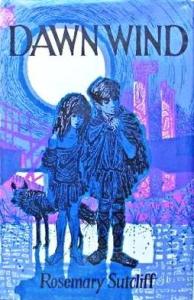
The Madonna del Rosario is an icon of Mary commonly dated to the sixth century or earlier. It is an early version of a type of icon known as the Agiosoritissa or the Maria Advocata, in which Mary is depicted without the Christ Child, with both hands raised. The work, which has been kept in the Church of the Madonna del Rosario since 1931, is thought to be the oldest image of Mary in Rome, Italy.[3] Medieval tradition held that the icon was painted by Luke the Evangelist.
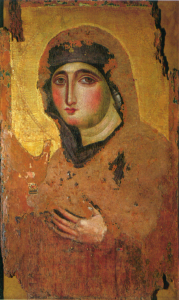
525: Having settled in Rome c. 500, Scythian monk Dionysius Exiguus (c. 470 – c. 544)invents the Anno Domini era calendar based on the estimated birth year of Jesus Christ.
Pope # 55 Non – Saint Boniface II ( September 22, 530 –17 October 17, 532) (2 years, 25 days) First Germanic pope. Changed the numbering of the years in the Julian Calendar from the Era of the Martyrs to Anno Domini.
c. 530 – The Rule of Saint Benedict is a book of precepts written in Latin by St Benedict of Nursia (c. AD 480–550) for monks living communally under the authority of an abbot.
So Saint Benedict wrote a handbook. It was chock full of great advice, from who should apologize after an argument, to how many times a day you should pray, to what you ought to do with old underwear, and whether you should sleep while wearing a knife. It was so useful, in fact, that within a hundred years, virtually every monastery in Europe adopted it. We know it today as The Rule of Saint Benedict, and it is used by monasteries all over the world, from Saint Louis Abbey in Missouri to Ndanda Abbey in Tanzania to Tupazy Abbey in Paraguay to Saint Willibrord’s Abbey in the Netherlands. In all, there are more than twelve hundred monasteries and twenty-five thousand Benedictines worldwide. I’m one of them.
-Augustine Wetta, J. Humility Rules: Saint Benedict’s Twelve-Step Guide to Genuine Self-Esteem (2017 ) Ignatius Press.
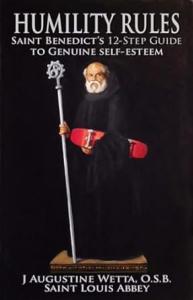
Lest Darkness Fall is a 1939 alternate history science fiction novel by the American author L. Sprague de Camp. Lest Darkness Fall is similar in concept to Mark Twain‘s A Connecticut Yankee in King Arthur’s Court, but the treatment is very different. American archaeologist Martin Padway is visiting the Pantheon in Rome in 1938. A thunderstorm arrives, lightning cracks, and he finds himself transported to Rome in 535 AD.
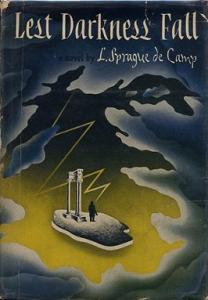
WORST YEAR EVER!!!!
536 -In 2018, medieval scholar Michael McCormick nominated 536 as “the worst year to be alive” because of the volcanic winter of 536 caused by a volcanic eruption early in the year, causing average temperatures in Europe and China to decline and resulting in crop failures and famine for well over a year.
Pope # 59 Non – Saint Vigilius (March 29, 537 –7 June 7, 555) (18 years, 70 days) Pope during the Second Council of Constantinople (553), the fifth ecumenical council recognized by the Catholic and Eastern Orthodox churches.
Catholic Ecumenical Council # 5
The Second Council of Constantinople (553)
This council repudiated the Three Chapters as Nestorian, condemned Origenism, and decreed the theopaschite formula.
Mid-6th century – Buddhist Jataka stories are translated into Persian by order of the Zoroastrian king Khosrau.
Dr. St. Isidore of Seville (c. 560 – 4 April 636) was a Hispano-Roman scholar, theologian, and archbishop of Seville. He is widely regarded, in the words of 19th-century historian Montalembert, as “the last scholar of the ancient world”. He composed The Etymologies also known as the Origins which is an etymological encyclopedia which summarized and organized a wealth of knowledge from hundreds of classical sources.
In 589 AD, the Chinese scholar-official Yan Zhitui makes the first reference to the use of toilet paper in history.
# 64 Dr. St. Gregory the Great (September 3, 590 – March 12, 604) (13 years, 191 days) The first pope formally to employ the titles Servus servorum Dei and Pontifex Maximus. He also established Gregorian chant. He became a Doctor of the Church in 1298.
Christ Pantocrator of Saint Catherine’s Monastery is one of the oldest Byzantine religious icons, dating from the 6th century AD. The earliest known surviving depiction of Jesus Christ as Pantocrator (literally ruler of all), it is regarded by historians and scholars among the most important and recognizable works in the study of Byzantine art as well as Eastern Orthodox and Eastern Catholic Christianity.
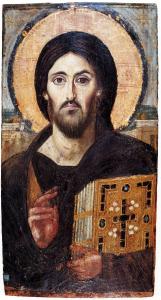
7th Century 600 – 699
Popes 65 – 84
9 Saint Popes
11 Non – Sainted Popes
0 Anti – Popes
The Wonder-Smith and His Son: A Tale from the Golden Childhood of the World is a children’s book by Ella Young. It is a collection of fourteen stories about Gubbaun Saor, the legendary Irish smith and architect. The book, illustrated by Boris Artzybasheff, was first published in 1927 and was a Newbery Honor recipient in 1928.
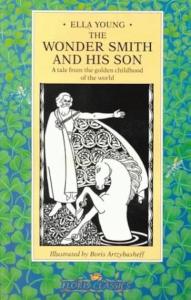
“Sancti venite” was composed at Bangor Abbey in the 7th century AD, making it the oldest known Eucharistic hymn.
Pope # 68 St Adeodatus I: (November 13, 615 – November 8, 618) (2 years, 360 days)The first pope to use lead seals on papal documents, which in time came to be called papal bulls.
Pope # 70 Non – Saint Honorius I (October 27, 625 – October 12, 638)(12 years, 350 days) Honorius was posthumously anathematized, initially for subscribing to monothelitism, and later only for failing to end it. The anathema against Honorius I became one of the central arguments against the doctrine of papal infallibility.
648-651 CE – The Afrasiab murals, also called the Paintings of the Ambassadors, is a rare example of Sogdian art. It was discovered in 1965 when the local authorities decided to construct a road in the middle of Afrāsiāb mound, the old site of pre-Mongol Samarkand. It is now preserved in a special museum on the Afrāsiāb mound.
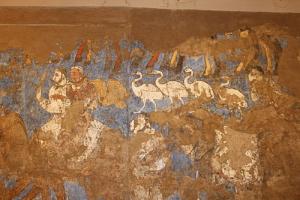
Pope # 74 St Martin I (July 5, 649 –12 November 12, 655) (6 years, 130 days) Last pope recognized as a martyr.
Pope # 79 St Agatho (June 27, 678 – January 10, 681) (2 years, 197 days) Pope during the Third Council of Constantinople (680), the sixth ecumenical council accepted by the Catholic and Eastern Orthodox churches.
Catholic Ecumenical Council # 6
The Third Council of Constantinople (680–681)
This council repudiated monothelitism and monoenergism.
610 – Muhammad, (c. 570 – June 8, 632 CE) Islamic prophet, begins at 40 years old to preach a religion which will be called Islam. According to Islamic teachings, the angel Gabriel appears to him in a cave on Mount Hira near Mecca (Saudi Arabia) and calls him: “The Prophet of Allah“. Muhammad gathers followers, reciting to them the first verses of Qur’an(Iqra), thus beginning the revelation of the Qur’an.
“[A] history of Islam’s origins cannot be written without reference to the origins of Judaism and Christianity – and […] a history of the origins of Judaism and Christianity cannot be written without reference to the world that incubated them both. The vision of God to which both rabbis and bishops subscribed, and which Muhammad’s followers inherited, did not emerge out of nowhere. The monotheisms that would end up established as state religions from the Atlantic to central Asia had ancient, and possibly unexpected, roots. To trace them is to cast a searchlight across the entire civilisation of late antiquity.”
― In the Shadow of the Sword: The Birth of Islam and the Rise of the Global Arab Empire
Dr. St. John of Damascus (676 – 749) He wrote works expounding the Christian faith, and composed hymns which are still used both liturgically in Eastern Christian practice throughout the world as well as in western Lutheranism at Easter. He is one of the Fathers of the Eastern Orthodox Church and is best known for his strong defence of icons. He also wrote an account of Buddha‘s life translated into Greek and was widely circulated to Christians as the story of Barlaam and Josaphat. He became a Doctor of the Church in 1890.
NEXT TIME ON
HOARATS
To Understand
What I love and How I Write About History
Hit the Link Above.
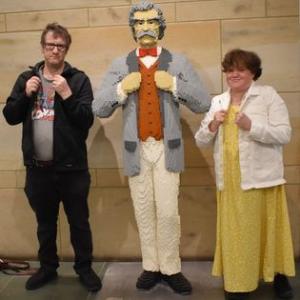
To understand about this particular series I’m writing about, please read
The Catholic Bard’s Guide To History Introduction
And to view a historical article click on


